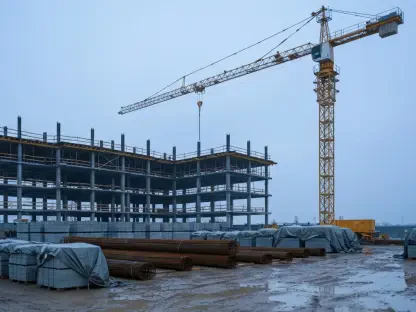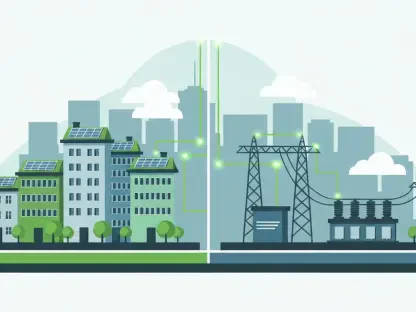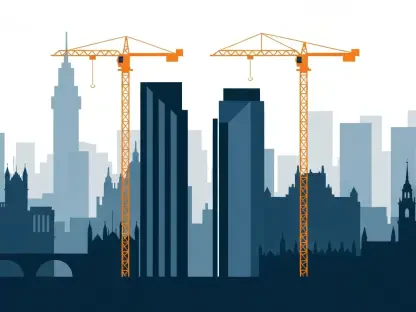The demand for environmentally friendly materials has reached unprecedented levels, as urban centers around the world continue expanding and requiring new infrastructure projects. Sustainable steel emerges as a cornerstone of this movement, reflecting a monumental shift within the steel industry. This progression aligns with broader global efforts to curb carbon emissions and advance toward an environmentally responsible future. As traditional steel production is phased out in favor of greener practices, sustainable steel stands as a testament to the fusion of technological innovation and ecological mindfulness. It represents not just a change in materials but a paradigm shift impacting the design, construction, and economic realities of future infrastructure projects.
Technological Innovations Leading the Way
Carbon Capture and Hydrogen-Based Steelmaking
In the sustained drive to create more environmentally friendly products, the steel industry is increasingly integrating cutting-edge technologies such as carbon capture and hydrogen-based steelmaking. These innovations play a pivotal role in achieving carbon neutrality, a primary objective for industries worldwide. By adopting such advancements, steel production becomes significantly less polluting. Carbon capture and storage (CCS) techniques remove harmful emissions from the production process, preventing millions of tons of carbon dioxide from entering the atmosphere annually. This strategy aligns with global efforts to meet climate targets set by international pacts and national governments.
Hydrogen-based steelmaking further represents a significant advancement in producing sustainable steel. By replacing coal with hydrogen during production, the process emits only water vapor instead of carbon dioxide, thus revolutionizing traditional steelmaking practices. This method offers a cleaner alternative and enhances the resulting steel’s properties, potentially leading to products with greater durability and longevity. The steel produced through these processes is gradually becoming the norm rather than the exception, helping to guide the industry toward greener futures. Continued research and development promise further refinements, minimizing costs and maximizing efficiency, making sustainable steel even more viable for widespread industrial use.
The Role of Startups and Green Projects
The rise of sustainable steel is not confined solely to established companies. Startups and newly launched green initiatives are especially vital in championing and mainstreaming these innovations. These entities often operate at the forefront of technology, illustrating the agile and adaptable nature required to meet modern environmental challenges. By investing heavily in research and development, startups drive the market forward, introducing new and groundbreaking processes that enhance both ecological and economic outcomes for producing steel. As a result, collaboration between these projects and larger firms increasingly accelerates progress toward comprehensive use.
Through the swift adaptation of sustainable practices, these green projects set a precedent for industry standards, pushing larger corporations toward similar transitions. With a focus on eco-friendly outputs, startups often benefit from governmental incentives, grants, and partnerships that bolster their growth. These investments have long-term impacts on the global steel industry. Beyond commemorating their achievements, recognizing the essential role these endeavors play in expediting global shifts is crucial. They actively promote technological innovations that bridge the gap between current practices and a sustainable future, fostering a culture of collaboration and shared goals throughout the steel production sphere.
Sustainable Steel and the Circular Economy
Redesigning Supply Chains
The integration of sustainable steel into the construction landscape extends beyond simple production modifications. It introduces transformative changes to supply chain management and design considerations within various industries, particularly those involved in heavy construction. By embracing principles of the circular economy, construction entities prioritize recycling and local production, thereby reducing the dependence on contentious international trade and mining operations. This shift reflects a strategic endeavor to localize supply chains, using recycled materials whenever possible, ultimately lowering transportation costs and contributing to regional economic stability.
The focus on redesigning supply chains paves the way for significant regulatory advantages, including adherence to new environmental standards without excessive overhead. The minimized reliance on external resources allows industries to better predict supply chain flows, improving project timelines and reducing unforeseen delays. These factors lead to an increasingly integrated and resilient construction sector, one in which sustainability and efficiency go hand in hand. This transition toward sustainable supply chain practices signals an era in which industrial developments and ecological mindfulness coexist, offering lessons that transcend national borders and resonate with global audiences.
Economic Implications and Lifecycle Costs
Switching to sustainable steel might involve initial financial investment; however, the long-term economic benefits clearly outweigh these early expenditures. In terms of lifecycle costs, sustainable steel proves advantageous, promising far-reaching positive impacts on the economics of construction-oriented enterprises. With enhanced recyclability and durability, sustainable steel structures often require far fewer repairs compared to traditional steel, leading to a reduction in upkeep expenses throughout their lifecycle. Companies and government entities involved in infrastructure planning witness substantial returns on investment due to fewer interruptions and increased longevity of structures.
Moreover, adopting sustainable practices grants access to various governmental incentives, tax breaks, and funding options aimed at promoting greener construction solutions. By integrating sustainable steel at the core of development plans, organizations exhibit a strong commitment to future infrastructure resiliency and global environmental strategies. This commitment fosters investor confidence, attracting stakeholders eager to support projects aligning with sustainability goals. Consequently, the transparent adoption of sustainable steel translates into competitive advantages, equipping businesses with prestige and desirability in an ever-evolving marketplace at a time when environmental evidence shapes consumer and partner choices alike.
Challenges and Opportunities
Overcoming Technological Costs and Infrastructure Limitations
Despite its forward trajectory, the sustainable steel industry nonetheless confronts vital challenges. Chief among these concerns are the substantial initial costs associated with adopting new technologies. Developing and implementing production techniques like hydrogen-based steelmaking require sizable investments in infrastructure. Supporting systems for carbon capture and hydrogen use are essential yet difficult to implement, especially in regions lacking advanced infrastructure. Innovation in these arenas offers numerous prospects, urging industries to achieve cost-effective production considering local resources and capabilities.
Regulatory complexities, especially in emerging markets, add layers of uncertainty to the practical rollouts of novel technologies. Yet, these hurdles also serve as powerful motivators for stakeholders within the industry. Many entities now recognize these challenges as opportunities for innovation that can result in substantial beneficial outcomes. By investing in advanced recycling techniques and other intermediate technologies, stakeholders effectively contribute to the seamless transition of these green initiatives, ultimately enabling successful integration. These challenges present an opportunity to galvanize collaboration among innovation leaders across the sector to expedite sustainable practices worldwide.
Advantages of Steel in Industrial Innovation
Steel’s intrinsic properties lend it remarkable utility in advancing technologically enlightened construction ventures, notably those that elevate environmental priorities. Its unparalleled strength and capacity make it the material of choice to construct skyscrapers, rail systems, and bridges designed to support substantial loads. The extensive off-site prefabrication of steel components significantly curtails build timelines, reducing costs associated with labor and fabrication. Such efficiencies facilitate swift responses to burgeoning infrastructure needs without unnecessary resource wastage or environmental disruption.
In addition, steel’s durable nature minimizes ongoing maintenance expenses across its life cycle, proving advantageous for both structural integrity and financial savings. By leveraging these intrinsic qualities, architects and construction professionals correlate innovation and sustainability with impeccable standards. The misconception that steel alone contributes to environmental harm is dispelled by promoting sustainable steel practices. Through innovation, dedication, and commitment to improvement, professionals within the steel industry continue to redefine perceptions, merging historical knowledge and forward-thinking goals into tangible realities.
Future Prospects and Industry Transformation
As urban centers worldwide continue to grow, the call for environmentally friendly materials has never been higher, necessitating new infrastructure projects that focus on sustainability. One of the leading innovations in this green revolution is sustainable steel, which has become essential in the global push to lower carbon emissions and promote an eco-conscious future. This shift marks a significant change not only within the steel industry but also in global building practices. The transition from traditional steel production methods to more sustainable alternatives is not merely a matter of substituting one material for another; it represents a comprehensive paradigm shift. This change is influencing the way infrastructure is designed and constructed, ensuring that future projects uphold economic and environmental sustainability. Sustainable steel, born out of technological advances and ecological awareness, is redefining how we think about building the cities of tomorrow, marrying industrial progress with the pressing need for sustainability.









